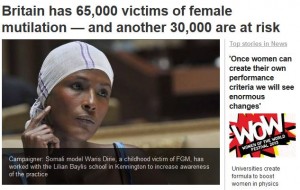Ìdábẹ́ jẹ ìkan nínú àṣà Yorùbá tí ólòdì si ẹ̀tọ́ àwọn obìnrin. Gẹ́gẹ́bí ìtàn ìdábẹ́, Yorùbá ndabẹ fún ob̀nrin ní àti ìkókó títí dé ọmọ ọdún kan, nwọn ní ìgbàgbọ́ wipe yio da ìṣekúṣe dúró lára obìnrin.
Tiítí òde òní, àṣà Yorùbá ṣì nfi ìyàtọ̀ sí àárín obìnrin ati ọkùnrin, ní títọ́ àti ní àwùjọ. Gẹ́gẹ́bí Olókìkí Oló́rin Jùjú Ebenezer Obey ti kọ́ lórin: “Àwa ọkùnrin le láya mẹ́fà, kò burú, ọkùnrin kan ṣoṣo lọba Olúwa mi yàn fún obìnrin”.
Gẹ́gẹ́bí Ìwé Ìròyìn Ìrọ̀lẹ́ ti ìlú London, ọjọ́ kẹfà oṣù kẹta, ọdún ẹgbẹ̀rún méji léní mẹ́tàlá, wọn ṣe àkíyèsí wípé àṣà ìdábẹ́ wọ́pọ̀ lãrin àwọn ẹ̀yà tó kéréjù ní Ìlú-Òyìnbó. Wọ́n ṣe àlàyé àlébù tí àṣà burúkú yi jẹ́ fún àwọn obìnrin tí wọ́n bá dábẹ́ fún, ara àlébù bi: ọmọ lè kú ikú ẹ̀jẹ̀ dídà, ìṣòro tí irú ẹni bẹ bá fẹ tọ̀, ìsòro ní ìgbà ìbímọ àti bẹbẹ lọ. Ìjọba ti pèsè owó pùpọ̀ lati fi òpin sí àṣà ìdábẹ́ ní Ìlú-Ọba.
Bí a ti nṣe àjọ̀dún “Ọjọ́ áwọn Obìnrin lagbaaye,” oṣe pàtàkì kí Yorùbá ní ilé àti ní àjò, di àṣà tí ó bùkún àwọn ọmọ mú, kí a sì ju àṣà tí ó mú ìpalára dání dànù. Ìdábẹ́ kò lè dá ìṣekúṣe dúró, nítorí kò sí ìwáìdí pé bóyá ó dá tàbí dín ìṣekúṣe dúró lãrin obìnrin. Ẹ̀kọ́ áti àbójútó lati ọ̀dọ́ òbí/alabojuto ló lè dá ìṣekúṣe dúró, ki ṣe ìdábẹ́.
English translation below:
THE CULTURE OF FEMALE GENITAL MUTILATION
Female Genital Mutilation (FGM) is an aspect of Yoruba Culture that does not conform with contemporary notions of women’s right. Female circumcision is widely practiced among the Yoruba people from birth till about first birthday. And it is believed to prevent promiscuity among women.
Till this this day, there is still discrimination in the upbringing and society’s perception towards female children as against male children. As the Juju Musician Ebenezer Obey once sang, “men can marry six wives at a time, it is not bad, only one man is chosen by God for a woman”.

London Evening Standard Article on female genital mutilation in the UK. An issue to be discussed on International Women’s Day — Somali model and advocate against female circumcision.
According to the London Evening Standard of Wednesday 6 March, 2013, it was observed that Female Genital Mutilation is rife among minority ethnic groups in Europe. Some of the consequences of this horrible culture to women who have been so mutilated include: the victim could bleed to death, difficulty passing urine, painful childbirth etc. The British Government has pledged £35 million towards eradication of Female Genital Mutilation in Britain.
As we celebrate International Women’s Day, it is important for Yoruba indigenes at home and abroad to hold on to culture that is dignifying and do away with culture that abases people. Female Genital Mutilation has not empirically been shown to prevent promiscuity. Parental training, nurture and caring is a better way to prevent promiscuity and not female genital mutilation.
Happy International women’s day.
Originally posted 2013-03-08 17:47:03. Republished by Blog Post Promoter



Thanks in a million for keeping the Yoruba culture and practice alive, and you as well quickening our consciousness regarding the obsolete cultural practice that is considered barbaric in our present days. Big thanks to you